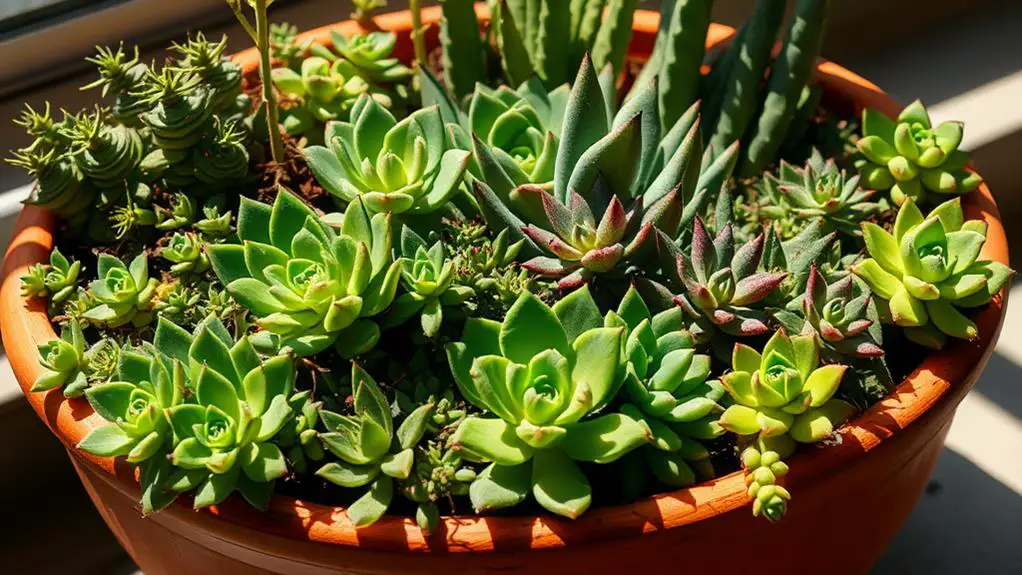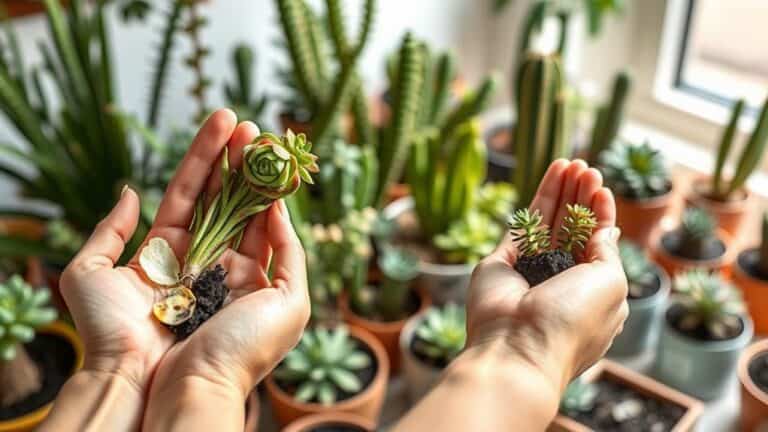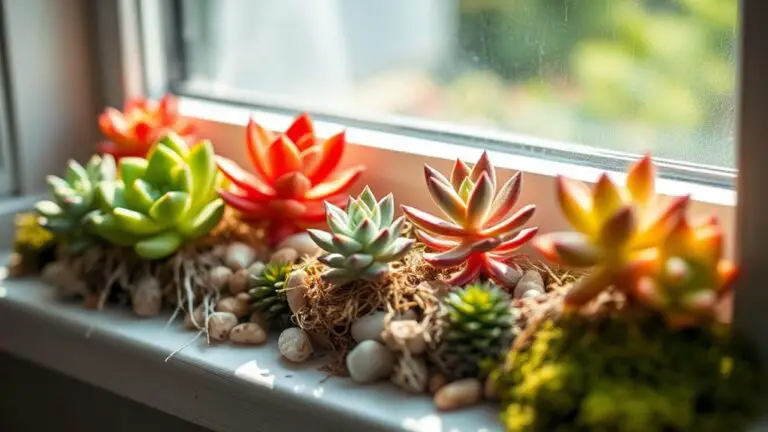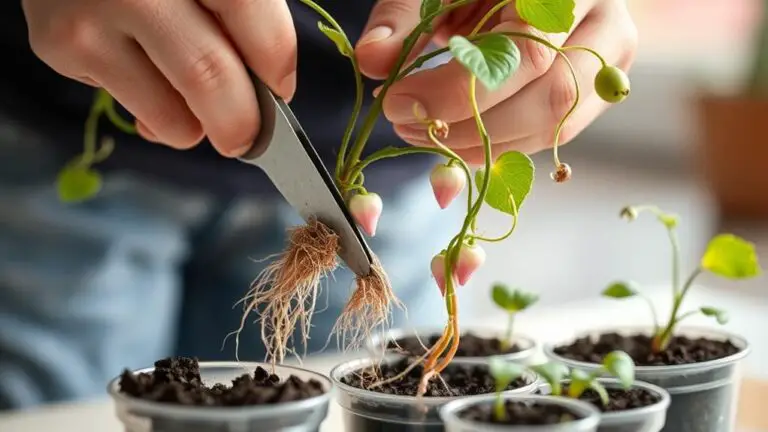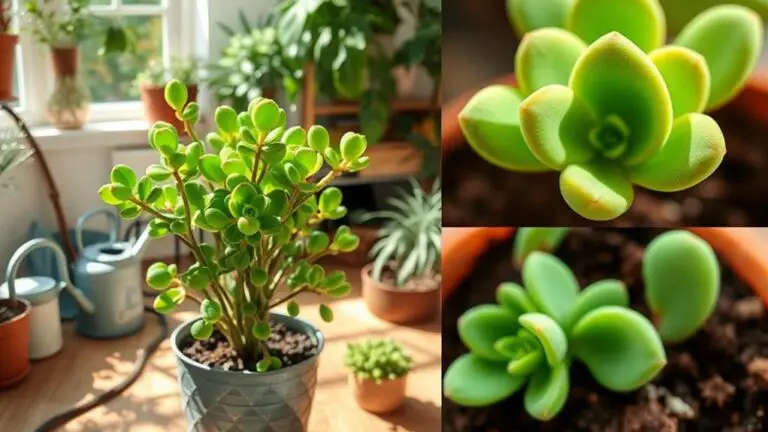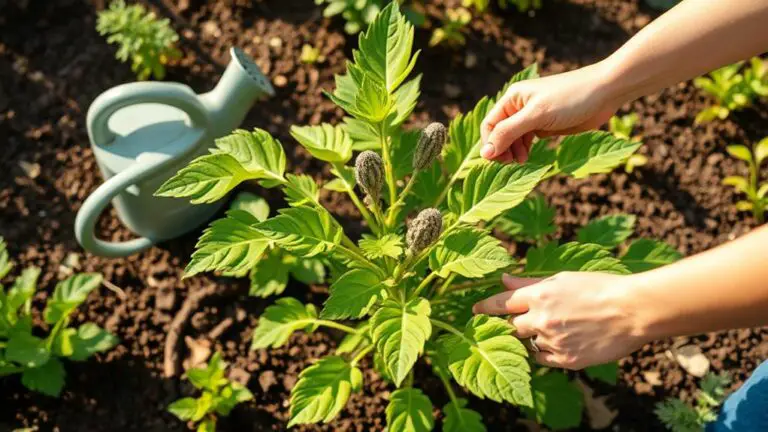7 Classic Green Succulents Perfect for Arrangements and Container Gardens
If you're considering adding some greenery to your arrangements or container gardens, seven classic green succulents might just be what you need. Varieties like Aeonium Canariense and Crassula Perforata offer unique features, ranging from vibrant rosettes to intriguing leaf shapes, that thrive in various light conditions. These succulents are low-maintenance and drought-resistant, making them perfect for both beginners and seasoned gardeners. Imagine the seasonal charm added by their pale yellow blooms. Curious about which other succulents made the list and why they're so ideal? Let's explore further.
Aeonium Canariense
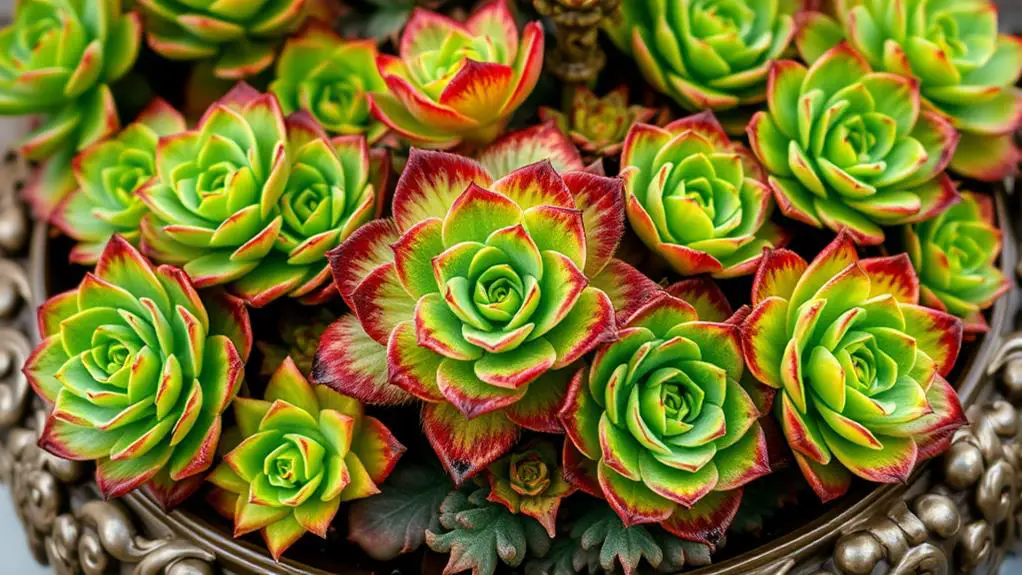
Aeonium canariense, often called the Giant Velvet Rose, is a standout succulent that's perfect for adding height and visual interest to your arrangements. This impressive plant features bright green rosettes that can turn a stunning red when exposed to full sun. It's a large, shrub-like succulent, reaching up to 3 feet tall, making it an eye-catching addition to any garden or container arrangement.
To grow Aeonium canariense successfully, you'll need to place it in a spot that receives full sun. This exposure not only enhances the vibrant colors but also guarantees healthy growth.
Another vital factor is well-draining soil. Aeonium canariense thrives in soil that allows water to flow through easily, preventing root rot. It's an ideal choice for sunny garden spots and low-water gardens due to its drought resistance.
One important thing to remember is that Aeonium canariense is monocarpic, meaning it will die after it blooms with its beautiful yellow star-shaped flowers. To keep your garden thriving, propagate the plant before it reaches this stage.
With minimal care, this succulent can be a delightful and rewarding addition to your gardening efforts.
Gasteraloe Green Ice
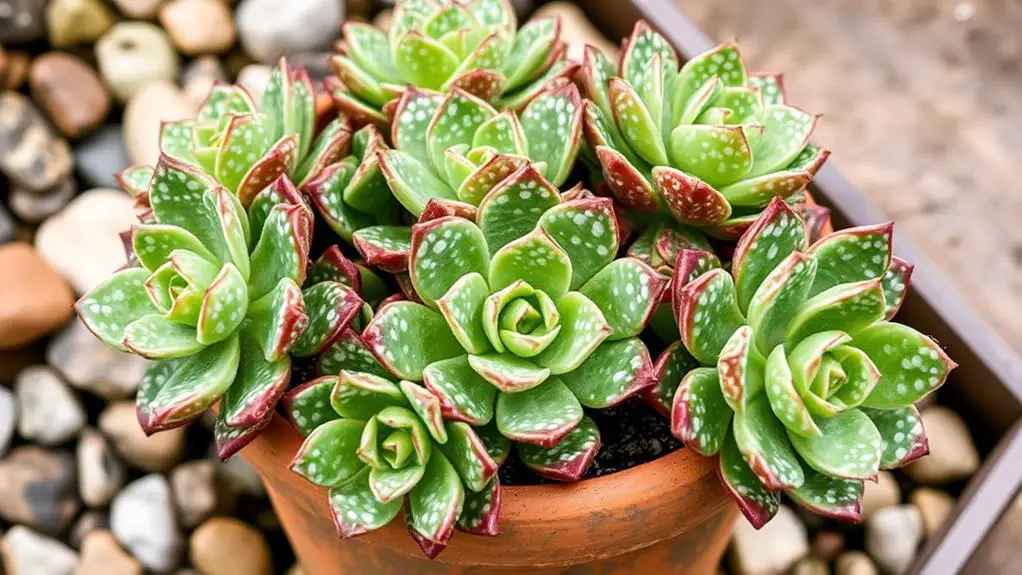
Gasteraloe Green Ice is a stunning succulent with thick, flat leaves marked by gray spots and lines that make it truly unique.
It's perfect for beginners because it's low maintenance and thrives indoors with bright, indirect light, though it can handle lower light too.
To add a touch of seasonal beauty, look out for its tubular flowers in red and green, which can brighten up any arrangement.
Variegated Leaf Patterns
With its distinctive variegated leaf patterns, Gasteraloe Green Ice stands out as a remarkable choice for succulent arrangements. This slow-growing succulent features thick, flat leaves adorned with unique gray spots and lines.
These variegated leaves not only enhance the beauty of your container garden but also guarantee your succulents thrive in various conditions.
Gasteraloe Green Ice is perfect for beginner gardeners because it requires minimal maintenance. You won't need to water it often, and it adapts well to different light levels, including low light. This makes it an excellent addition to any indoor container garden.
Here are some reasons why Gasteraloe Green Ice is a fantastic choice:
- Low Maintenance: Minimal watering and care needed.
- Adaptable: Thrives in various light conditions, including low light.
- Visually Appealing: Distinctive variegated leaves with gray patterns.
- Hardy: Suitable for beginner gardeners.
During its blooming season, Gasteraloe Green Ice produces tubular flowers in shades of red and green, adding a vibrant touch to your arrangement.
Its low drought resistance means it can handle some neglect, making it easy to keep alive and healthy. With Gasteraloe Green Ice, you're guaranteed a beautiful and resilient addition to your succulent collection.
Indoor Growth Tips
While appreciating the variegated beauty of Gasteraloe Green Ice, it's equally important to know how to cultivate it indoors effectively. This unique succulent thrives best in bright, indirect light. So, place it near a window where it can soak up plenty of sunlight without being exposed to direct rays. This positioning guarantees your Gasteraloe Green Ice remains healthy and vibrant.
For your succulent container garden, choose a pot with drainage holes. This is essential because Gasteraloe Green Ice prefers well-drained soil to prevent root rot. A cactus-specific potting mix works perfectly, guaranteeing the soil doesn't hold excess water.
Remember, these succulents are drought-resistant. Water only when the top inch of soil is dry, making it a low-maintenance option for busy individuals or beginners.
Gasteraloe Green Ice's thick, flat leaves with gray spots add a striking visual element to any indoor arrangement. Additionally, it produces red and green tubular flowers, adding seasonal interest to your space when it blooms.
Crassula Perforata

Crassula perforata, also known as String of Buttons, offers a striking look with its unique triangle-shaped leaves that spiral around the stem.
You'll love how its gray-green leaves can develop pinkish edges under bright light, making it a standout in any arrangement.
Plus, it's perfect for indoor conditions and blooms pale yellow flowers in spring, adding an extra touch of charm.
Unique Spiral Growth
Admiration for Crassula perforata, commonly known as String of Buttons, often stems from its unique spiral growth pattern. This succulent is a fantastic choice for your container garden, thanks to its visually striking appearance and easy care.
The triangle-shaped leaves grow in pairs, wrapping around the stem in a perfect spiral, which makes it a standout addition to any arrangement.
You'll find the leaves are typically gray-green with charming pinkish edges when exposed to bright light. This color contrast adds to the plant's aesthetic appeal.
Additionally, in the spring, Crassula perforata blooms with pale yellow flowers, adding a pop of color to your garden display.
Here's why you'll love adding Crassula perforata to your succulent collection:
- Unique spiral leaf pattern: The leaves grow in a mesmerizing spiral, creating an eye-catching display.
- Colorful edges: Exposure to bright light enhances the pinkish edges, making the plant even more attractive.
- Spring blooms: Pale yellow flowers provide seasonal color to your container garden.
- Low maintenance: This drought-resistant plant requires minimal water, perfect for both novice and experienced growers.
Ideal Indoor Conditions
To successfully grow Crassula perforata indoors, you'll need to provide the right conditions. These succulents need bright, indirect light to thrive. Place them near a window where they can get plenty of illumination without being exposed to direct sunlight. This will help the leaves develop their charming pinkish edges, adding visual interest to your indoor space.
Crassula perforata prefers well-draining soil, which is vital for preventing root rot. You can use a cactus or succulent mix to guarantee proper drainage.
When it comes to watering, only do so when the top inch or two of the soil feels dry. Overwatering is a common mistake, but sticking to this routine will keep your plant healthy and happy.
This succulent is low-maintenance and drought-resistant, making it perfect for beginners or anyone seeking an easy-care houseplant. Its compact growth habit with triangular, gray-green leaves makes it an attractive addition to any indoor arrangement.
Seasonal Flower Blooms
Beyond just thriving indoors, Crassula perforata offers a delightful seasonal bonus with its pale yellow flowers that bloom in spring.
These delicate yellow flowers emerge from the tips of its unique triangle-shaped leaves, creating a visually striking display. When properly cared for, this succulent will reward you with beautiful seasonal flower blooms, adding a charming touch to your arrangements and container gardens.
To guarantee your Crassula perforata flourishes and produces its lovely blooms, keep a few key points in mind:
- Bright Light: This succulent thrives in bright light, which promotes more abundant flowering and vibrant leaf coloration.
- Well-Established Plants: Blooms typically occur when the plant is well-established and healthy.
- Optimal Conditions: The flowering period can vary slightly depending on growing conditions but often peaks in late spring to early summer.
- Companion Plants: Pair it with other succulents like echeveria for a stunning combination.
Haworthiopsis Reinwardtii
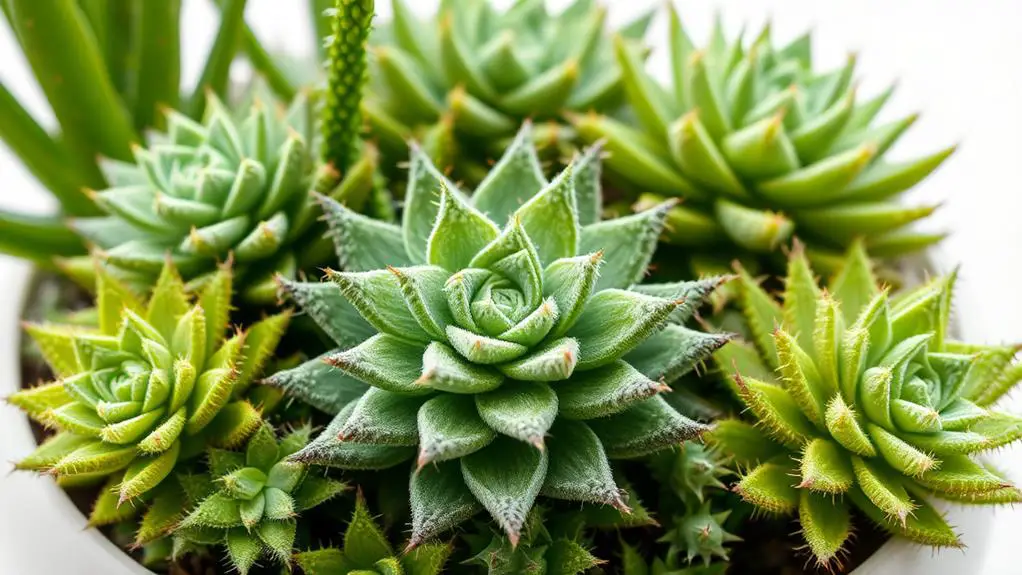
Haworthiopsis reinwardtii, often cherished for its compact size and unique appearance, is a standout choice for succulent enthusiasts. This small succulent is perfect for anyone who appreciates minimal care requirements and has limited space. Its large, pointed leaves spiral upwards in a columnar form and are covered with distinctive white bumps, giving it a striking look.
You'll find that Haworthiopsis reinwardtii thrives in low-light environments, making it an ideal addition to indoor arrangements and decorative pots. Whether you're a novice or an experienced grower, this plant's ability to tolerate neglect guarantees it will continue to flourish with minimal effort. It's especially handy if you're prone to forgetting to water your plants every now and then.
During spring, you might notice pale yellow flowers blooming, although the real attraction is its unique foliage. Its small clumping habit makes it a fantastic choice for terrariums or mixed succulent arrangements, fitting seamlessly into any small space you have available.
With Haworthiopsis reinwardtii, you can enjoy the beauty of succulents without the hassle, making it a delightful addition to your plant collection.
Kalanchoe Beharensis Fang
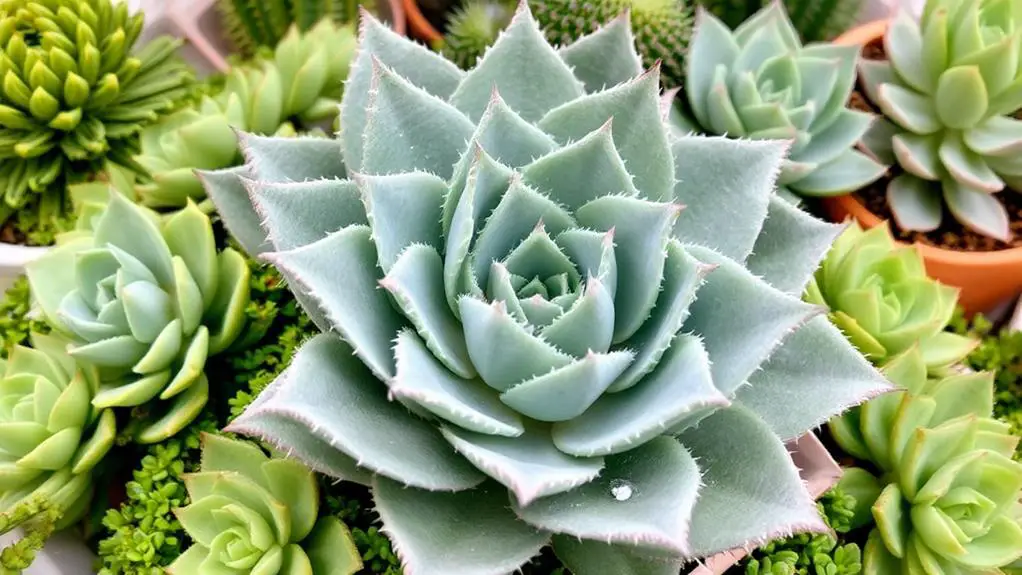
Moving from the compact elegance of Haworthiopsis reinwardtii, let's explore the bold character of Kalanchoe beharensis Fang. This tall succulent stands out with its velvety silver leaves, each adorned with tiny tubercles that give it a unique, fang-like appearance.
The leaf edges have a striking bronze hue, adding visual interest and making it an enthralling addition to your collection.
Kalanchoe beharensis Fang thrives in well-draining soil and requires minimal care, making it perfect for both beginners and experienced gardeners. You'll love how easy it's to maintain and how stunning it looks in decorative pots.
Although it rarely flowers indoors, its red-orange blossoms in the spring are a delightful surprise when grown outdoors.
Here's why you might want to add Kalanchoe beharensis Fang to your garden:
- Unique foliage: The velvety, fang-like leaves are truly one-of-a-kind.
- Striking colors: Bronze leaf edges and silver leaves create a beautiful contrast.
- Low maintenance: Thrives in well-draining soil with minimal care.
- Decorative potential: Perfect for eye-catching indoor arrangements and decorative pots.
Sedum Reflexum

Among the versatile and resilient succulents, Sedum reflexum stands out with its hardy nature and vibrant foliage. This plant, also known as reflexed stonecrop, features fleshy, yellow-green leaves that often shift to a beautiful blue-green hue under sunlight.
If you're looking for a drought-tolerant option, Sedum reflexum is perfect for you. It produces small, star-shaped yellow flowers in the summer, attracting bees and butterflies to your garden.
To guarantee your Sedum reflexum thrives, plant it in well-draining soil. This type of soil prevents water from sitting around the roots, which can cause rot. The plant does best in full sun to partial shade, making it ideal for various spots in your garden.
Whether you prefer rock gardens, container arrangements, or ground cover, this succulent fits right in.
One of the best things about Sedum reflexum is its resilience. It can tolerate poor soil conditions and is hardy in USDA zones 3 to 9, so it suits many climates.
Its unique trailing growth habit makes it a fantastic choice for hanging baskets and cascading arrangements, adding a touch of elegance to any display.
Sedum Pachyphyllum
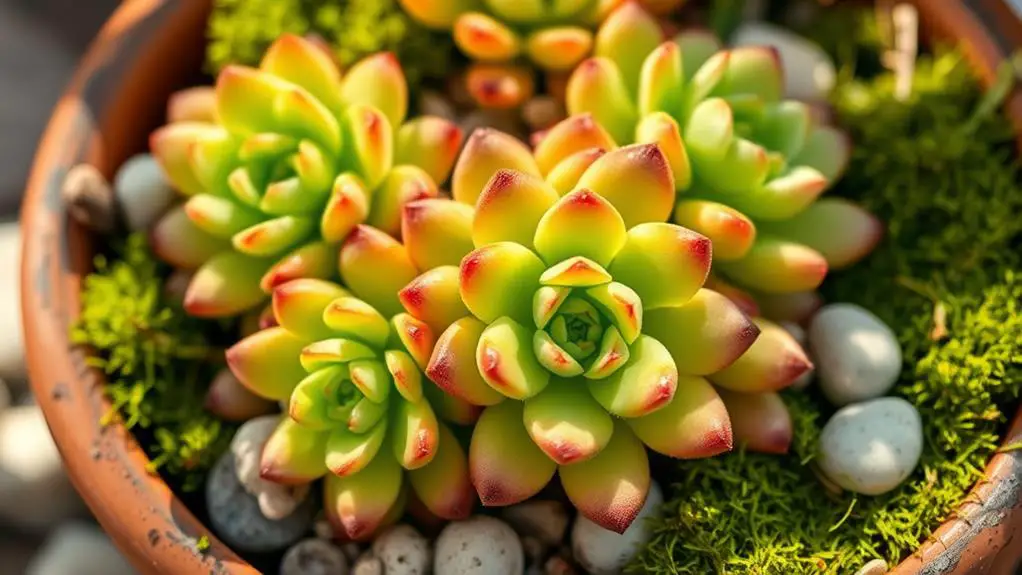
If you're looking for a striking and low-maintenance succulent, Sedum pachyphyllum, commonly known as the Jelly Bean Plant, is an excellent choice. Its thick, fleshy leaves are green with a slight yellowish hue, resembling jelly beans. This unique appearance makes it a fun and attractive addition to any garden.
Sedum pachyphyllum is a low-growing variety, typically reaching heights of 6 to 12 inches. This makes it perfect for container arrangements and ground cover. It thrives in full sun to partial shade and needs well-draining soil to prevent root rot.
Here are some key points to remember for growing Sedum pachyphyllum:
- Height: Grows up to 6 to 12 inches
- Light: Thrives in full sun to partial shade
- Soil: Requires well-draining soil to prevent root rot
- Flowers: Produces small, star-shaped yellow flowers in late spring to early summer
This drought-tolerant succulent is easy to care for and can withstand heat, making it an excellent choice for low-maintenance gardens.
Whether you're an experienced gardener or just starting out, Sedum pachyphyllum will add visual interest and charm to your outdoor space with minimal effort.
Frequently Asked Questions
What Is the Best Succulent Plant for Pots?
You'll love Echeveria for pots because of its stunning rosette shape and colorful varieties. It thrives in well-draining soil, needs little watering, and adds a beautiful focal point to any container garden or arrangement.
What Succulents Can Be Planted Together in Pots?
You can plant succulents together in pots by combining those with similar light and water needs. Pair drought-resistant types like Aloe and Sedum or mix visually complementary varieties like Echeveria 'Perle von Nurnberg' with Echeveria 'Mexican Snowball'.
What Are the Best Combinations for Succulents?
Pair Echeveria rosettes with trailing Sedum for contrast. Group drought-tolerant Aloe and Gasteraloe together. Mix upright Haworthiopsis with trailing Crassula for depth. Combine velvety Kalanchoe and smooth Aeonium for texture. Rotate for seasonal interest.
How Do You Make a Succulent Container Garden?
Choose a well-draining soil mix, select complementary succulents, and make certain your container has drainage holes. Water thoroughly but infrequently, and place the container in a sunny spot. These steps help you create a thriving succulent garden.
Conclusion
You've got everything you need to start your succulent garden! These seven classic green succulents, like Aeonium Canariense and Crassula Perforata, are perfect for adding charm to your arrangements and container gardens. They're easy to care for and can thrive in different light conditions. Plus, their unique features and seasonal blooms make them a beautiful addition to any space. So go ahead, give it a try, and enjoy the beauty of your new succulent collection!

